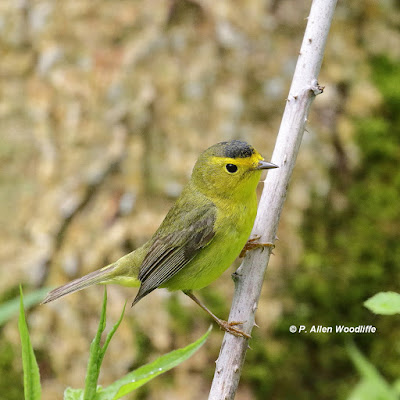It has been wet this last week or so. How wet you ask? In about a 5 day period, we had approximately 10 cm (4") of rain. Many farm fields were saturated, and there is still standing water in places. Rondeau was subject to high water levels to begin with, but with the latest rain fall, there is no where for the water to go. As a result, trails are as wet as I have ever seen them for this time of year. The South Point Trail in particular is flooded. This first photo shows what it is like as you begin the east side access.
A closer look, and maybe you can see that something has been added to this sign.
If you get this far, you probably already have boots on, or have very wet feet!
Much of the trail, probably about 90% of it, looks like this.
While walking through the water, it was quite obvious that the earthworms actively crawling on the flooded road and were trying to escape the deluge.
There aren't a lot of birds either, but it looks promising for Swamp Sparrows!
Even the north part of the park hasn't been spared. Some cottages are surrounded by water, and water is flowing or standing over the road in places. This is the first time in my memory, and perhaps ever, that the campground has been closed on the Victoria Day weekend! Campsites and especially the roads are flooded.
But bird migration continues, and there have been some days with good numbers of birds. On one of those days I spent several hours on the maintenance trail loop, as well as on the ridge leading south of it, and had 72 species including 21 warblers. It started off as a dull day with heavy overcast and the continued threat of rain, so for awhile I didn't even bother with the camera. However a bit later I had it out, and got some shots of Wilson's Warbler.
A bright male Scarlet Tanager showed up through the shrubbery for a few moments.
Eventually I got a less obscured view and photo.
A pair of Wood Ducks were very close to the trail.
Squirrels were spending more time in the trees than on the wet ground.
A bit later the sky cleared. Someone had noticed a bump on a branch ~ 23 metres (75') up in a tree. This first photo is the equivalent of a 10X binocular.
A cropped view, below, shows the long tail and the heavily barred sides. Even though there had been some birders conclude this was a Whip-poor-will, the features shown as well as the extreme height of the bird clearly makes this a Common Nighthawk.
On another occasion, I had the privilege of accessing a private property just south of Mitchell's Bay. A Cattle Egret and several Yellow-headed Blackbirds had been sighted in the area from time to time. The access I had gave me the opportunity to see and photograph both. Cattle Egrets are not native to North America, but a few landed in the southern USA several decades ago, and have gradually expanded. They show up periodically in Ontario, and on very rare occasion, have nested. Nonetheless it is not a species one normally expects to see here.
The egret was having a lot of success finding earthworms that were trying to escape the very saturated soil.
I saw three adult male Yellow-headed Blackbirds as well as six females. The females were in a group farther away and I didn't get any satisfactory photos of them this time. This species is very much a western one, but due to the similarity of the Lake St. Clair marshes and adjacent flatlands, a few have been present annually for several decades. Their nesting site has changed over the years, and is becoming increasingly difficult to pin down.
I noted that several birds would make an exit heading due west, presumably out to a part of the marsh where they were nesting. I hope to get my kayak out one of these days and see this first hand.




















No comments:
Post a Comment